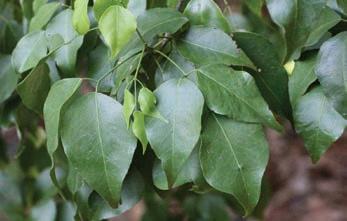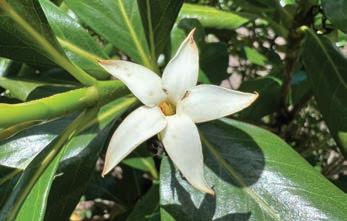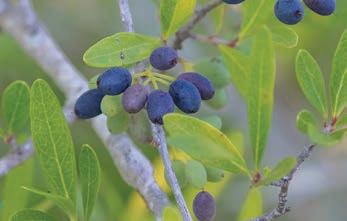FREQUENTLY ASKED QUESTIONS
Below are answers to the TOP FIVE questions our staff have received since Ian.
1How long should I wait before replanting based on the salt content in the soil?
While the salinity of your soil has likely increased from the storm surge, we’ve also received some rain since the storm. The more rain that falls, the more salinity levels will decrease in the soil. Replanting with moderately or highly salt-tolerant plants should be okay, though some experimentation may be necessary depending on individual circumstances.
Start with smaller, less expensive plants as a test, and then continue once you’re assured that salinity in your soils is not a problem. Replanting with salt-sensitive plants should wait until next summer when rains have begun again.
2What is the “muck” that covered my yard?
The “muck” is sediment that was brought onto land from the storm surge during Ian. While we don’t know the exact makeup of the sediment, we suspect that it is a clay-based substance from the bottom of the Gulf of Mexico that was churned up during the storm. When Ian came through, the sediment came with it and then settled out of the water as the water receded. It is likely high in sulfur with a high pH.

2 SCCF — Post-Hurricane Ian Replanting Guide
If you have a substantial layer of muck in your yard, you may want to manually remove it from high-priority areas. It seems easiest to remove when it’s dried and cracked and you can pick it up in chunks. But, any method that is easiest for you would work. You may also mix it in with the existing soil, but that may prove to be difficult depending on the amount. For smaller amounts, you may leave it as-is.
Given the composition of the sediment is unknown at this time and could contain bacteria or heavy metals, we advise refraining from planting edible plants where large amounts of sediment remain. Remove gardening shoes before entering your house and wash your hands thoroughly after touching the soil.
3How do I care for smaller storm-damaged shrubs and trees?
If your plant is alive, but looks a bit tattered, a good “once over” may help it survive and regain health. First, check the root zone; if covered in excess soil or debris, remove it down to the original soil level. Conversely, if the soil has been scoured away from the base of the plant, add soil or compost to any exposed roots. Do not add excess soil; use just enough to cover what has been exposed. Water to the drip line of the tree or shrub to dilute and flush out any excess salt from the root zone. If you need to stake or reset the plant completely, treat it as if it is newly planted, and water accordingly to help damaged roots re-establish. Additionally, storm-damaged plants do not necessarily need fertilization for the first year while they reestablish. Instead, keep an eye out for nutritional deficiencies and only treat them if needed.

3 SCCF — Post-Hurricane Ian Replanting Guide
4What do I do with large storm-damaged trees?

If you have a large tree with broken and/or twisted branches, you should call a professional tree service. It is healthier for the tree to receive clean pruning cuts. Avoid going underneath the tree — especially on a windy day — as some of those broken branches can fall unexpectedly.
5How do I tell if a plant is totally dead?
Some of our native plants require several months to build up enough energy to put out new growth. If you have a plant that looks dead in your yard, please be as patient as possible to see if it’s potentially alive and give it the longest possible time to allow it to resprout. Many of our natives will resprout from the trunk — a phenomenon called epicormic growth. Some will even resprout from the base of the plant or at the roots.
If you’re unsure if a plant is dead, you can check by doing “the scratch test.” With your fingernail or a small set of pruners, lightly scratch underneath of the bark of the plant while causing as little damage as possible. Underneath the first outside layer of bark there is a living layer called the cambium, which should be green and very thin. Inside of that layer will be the “wood” of the plant. Once you scratch the surface, if the plant is alive, then you should be able to see the green cambium layer. If you only see brown, it is likely that the plant is dead and can be removed. Note that sometimes it is difficult to see the cambium layer, and performing the scratch test in several places is advised. If it’s a multi-trunked plant, it’s possible that one trunk is alive while the rest are dead. Please note that palms, being monocots like grasses, grow differently and do not have a cambium layer.

4 SCCF — Post-Hurricane Ian Replanting Guide
PLANTS THAT SURVIVED THE HURRICANE
SCCF staff have been pleasantly surprised at the resilience of many of our plants in standing up to a storm surge of 5-plus feet. Below is a list of plants we’ve observed surviving in multiple places on the islands and would recommend for use in replanting. Please note that this list is not exhaustive.
PALMS
Cabbage
, up to 60 feet tall, full sun to part shade, moist to dry soils
Royal Palm (Roystonea regia), up to 75 feet tall, full sun to part shade, dry to wet soils


Paurotis Palm (Acoelorraphe wrightii), 15-20 feet tall, full sun to part shade, moist to wet soils
Saw Palmetto, Green & Silver (Serenoa repens), 6-8 feet tall, full sun to part shade, dry to moist soils


5 SCCF — Post-Hurricane Ian Replanting Guide
Palm (Sabal palmetto)
TREES
Black Mangrove (Avicennia germinans), 20-30 feet tall, full sun to part shade, moist to wet soils



Thatch Palm, Green & Silver (Thrinax radiata, Thrinax morrisii), 15-20 feet tall, full sun to part shade, moist to dry soils

Cat’s Claw (Pithecellobium unguis-cati), 10-15 feet tall, full sun to part shade, moist to dry soils
Cinnamon Bark (Canella winterana), 20-30 feet tall, full sun to part shade, dry to moist soils
Crabwood (Gymnanthes lucida), 20-30 feet tall, full sun to part shade, dry to moist soils

6 SCCF — Post-Hurricane
Replanting Guide
Ian
Green Buttonwood (Conocarpus erectus), 20-30 feet tall, full sun to part shade, moist to wet soils



Joewood (Jacquinia keyensis), 1020 feet tall, full sun to part shade, dry to moist soils
Gumbo Limbo (Bursera simaruba), grows to 40 feet tall, full sun to part shade, dry soils

Lignum Vitae (Guaiacum sanctum), grows to 25 feet tall, full sun to light shade, dry to moist soils

Jamaica Dogwood (Piscidia piscipula), 30-40 feet tall, full sun to light shade, dry to moist soils
Pigeon Plum (Coccoloba diversifolia), 20-40 feet tall, full sun to part shade, dry to moist soils

7 SCCF — Post-Hurricane Ian Replanting Guide
Red Mangrove (Rhizophora mangle), 30-40 feet tall, full sun to part shade, moist to wet soils

Strangler Fig (Ficus aurea), 4060 feet tall, full sun to part shade, dry to moist soils

Seagrape (Coccoloba uvifera), 2530 feet tall, full sun to part shade, dry to moist soils

Sweet Acacia (Vachellia farnesiana), 10-12 feet tall and wide, full sun to part shade, dry soils

Silver Buttonwood (Conocarpus erectus), 20-30 feet tall, full sun, dry to moist soils

Torchwood (Amyris elemifera), 20-40 feet tall, full sun to part shade, dry to moist soils

8 SCCF — Post-Hurricane
Replanting Guide
Ian
White Mangrove (Laguncularia racemosa), 30-40 feet tall, full sun, moist to wet soils
Wild Tamarind (Lysiloma latisiliquum), 40-60 feet tall, full sun to part shade, dry to moist soils


Wild Lime (Zanthoxylum fagara), 12-25 feet tall, full sun to part shade, dry to moist soils


SHRUBS
Bay
Beautyberry

9 SCCF — Post-Hurricane
Replanting Guide
Ian
Cedar (Suriana maritima), 1015 feet tall, full sun to part shade, dry soils
(Callicarpa americana), 4-8 feet tall, full sun to part shade, dry to moist soils
Black Torch (Erithalis fruticosa), 4-8 feet tall, full sun to light shade, dry to moist soils
Limber Caper (Cynophalla flexuousa), 12-20 feet tall, full sun to part shade, dry soils

Christmas Berry (Lycium carolinianum), 5-10 feet tall, full sun to part shade, moist to wet soils

Myrsine (Myrsine cubana), 15-20 feet tall, full sun to part shade, dry to moist soils
Jamaica Caper (Quadrella jamaicensis), 15-20 feet tall, full sun to part shade, dry to moist soils


Marlberry (Ardisia escallonioides), up to 20 feet tall, part shade to full shade, dry to moist soils


10 SCCF — Post-Hurricane
Replanting Guide
Ian
Seven Year Apple (Genipa clusiifolia), 8-10 feet tall, full sun to part shade, dry to moist soils

White Indigo Berry (Randia aculeata), 8-10 feet tall, full sun to part shade, dry to moist soils

Simpson’s Stopper (Myrcianthes fragrans), 15-25 feet tall, full sun to part shade, dry to moist soils
Wild Olive (Forestiera segregata), 4-15 feet tall, full sun to part shade, dry to moist soils

GROUNDCOVERS, WILDFLOWERS, GRASSES, & FERNS
Blue Flag Iris (Iris virginica), 3-4 feet tall, full sun to part shade, moist to wet soils

Blue Porterweed (from seed) (Stachytarpheta jamaicensis), grows to 2 feet tall, full sun to part shade, dry to moist soils


11 SCCF — Post-Hurricane
Guide
Ian Replanting
Bull-tongue Arrowhead (Sagittaria lancifolia), grows up to 5 feet tall, full sun to part sun, wet soils
Dune Sunflower (from seed) (Helianthus debilis), 1-2 feet tall, full sun, dry soils

Coontie (Zamia pumila), 2-4 feet tall, full sun to full shade, dry soils
Frostweed (Verbesina virginica), 4-6 feet tall, full sun to part shade, dry to wet soils


Coral Honeysuckle (Lonicera sempervirens), climbs 10-15 feet tall, full sun to part shade, dry to moist soils

Giant Leather Fern (Acrostichum danaeifolium), 6-8 feet tall, full sun to part shade, moist to wet soils


12 SCCF — Post-Hurricane
Replanting Guide
Ian
Gopher Apple (Licania michauxii), 1-3 feet tall, full sun, dry soils
Mimosa (Mimosa strigillosa), 4-6 inches tall and spreading, full sun to part shade, dry to moist soils

Lizard’s Tail (Saururus cernuus), grows up to 3 feet tall, full sun to part shade, moist to wet soils
Muhly Grass (Muhlenbergia capillaris), 2-4 feet tall, full sun to light shade, moist to dry soils

Milkweed (Asclepias spp.), grows up to 5 feet tall, full sun to part shade, moist to wet soils



Rouge Plant (from seed) (Rivina humilis), 2-4 feet tall, full sun to part shade, dry to moist soils

13 SCCF — Post-Hurricane Ian Replanting Guide
Sand Cordgrass (Spartina bakeri), 3-5 feet tall, full sun to light shade, moist to wet soils

Spiderwort (Tradescantia ohiensis), grows up to 2 feet tall, full sun to part shade, moist to dry soils

Seaside Goldenrod (Solidago sempervirens), 3-5 feet tall, full sun to part shade, dry to moist soils

String Lily (Crinum americanum), 2-3 feet tall, full sun to part shade, moist to wet soils

Sea Oxeye Daisy (Borrichia frutescens), grows up to 3 feet tall, full sun to part shade, dry to moist soils

Yellowtop (from seed) (Flaveria linearis), 2-3 feet tall, full sun to part shade, moist to dry soils

14 SCCF — Post-Hurricane
Replanting Guide
Ian
Yellow Canna Lily (Canna flaccida), 2-5 feet tall, full sun to light shade, moist to wet soils
Contact the SCCF Native Landscapes & Garden Center to keep your landscape thriving in our unique island climate. info@sccf.org | 239-472-1932 www.SCCF.org

15 SCCF — Post-Hurricane Ian Replanting Guide
HOW-TO GUIDE FOR NEW PLANTINGS
1Step 1: Choosing a proper location
Your planting area should suit the plant’s moisture and light requirements. Space your plants with their mature size in mind, including their height, width, and root spread. Also ensure that when your plant is fully grown, it won’t interfere with power lines, foundations, sidewalks, or other plants.
2Step 2: Planting
It’s important to plant as quickly as possible so that there is minimal shock to the plant. When digging the hole, dig twice as wide as the pot and slightly shallower than the pot is tall. Place the soil to the side to keep for backfill. Fill the hole with water; then gently remove the plant from the pot without breaking the roots. Place the plant in the hole. It is important that the top of the plant’s rootball is level with or slightly higher than the surrounding soil (see diagram). Once the plant is in place, fill the spaces around the roots with the soil you set aside, making sure to remove any air pockets. Press the soil lightly around the root ball to secure the plant. If necessary, properly stake the plant.

HOLE IS SLIGHTLY DEEPER THAN CONTAINER
HOLE IS 2X AS WIDE AS CONTAINER
TOP OF ROOTS ARE LEVEL WITH EXISTING SOIL
16 SCCF — Post-Hurricane Ian Replanting Guide
3Step 3: Watering
Once you have backfilled the hole, give the plant a good steady soak around the base. Keeping the weather in mind, follow the watering guidelines below until your plant becomes established (see below for establishment times). If placed in the proper location, your plant should not need supplemental irrigation once established.
WATERING GUIDELINES:
• First two weeks: every other day
• Next two months: 2 times per week
• 2-6 months: 1 time per week, or as needed
• As needed until establishment (see below for establishment guidelines)
ESTABLISHMENT TIMES:
• Herbaceous annuals, perennials, ferns, aquatics: 2-4 weeks
• Small shrubs: 1-3 months
• Larger shrubs, palms, trees: 6 months to over 1 year
4Step 4: Mulching
Mulch helps to retain essential moisture in the soil as well as create a barrier for weeds. Spread 3”-4” of mulch around your new plant; make sure that the mulch is pulled away from the base of your plant and its root ball to avoid fungal growth.
17 SCCF — Post-Hurricane Ian Replanting Guide
Help us “tree”-build by sponsoring a new plant or purchasing a gift card to the garden center at tinyurl.com/TreebuildSCCF
Contact the SCCF Native Landscapes & Garden Center to keep your landscape thriving in our unique island climate. info@sccf.org | 239-472-1932 www.SCCF.org
































































